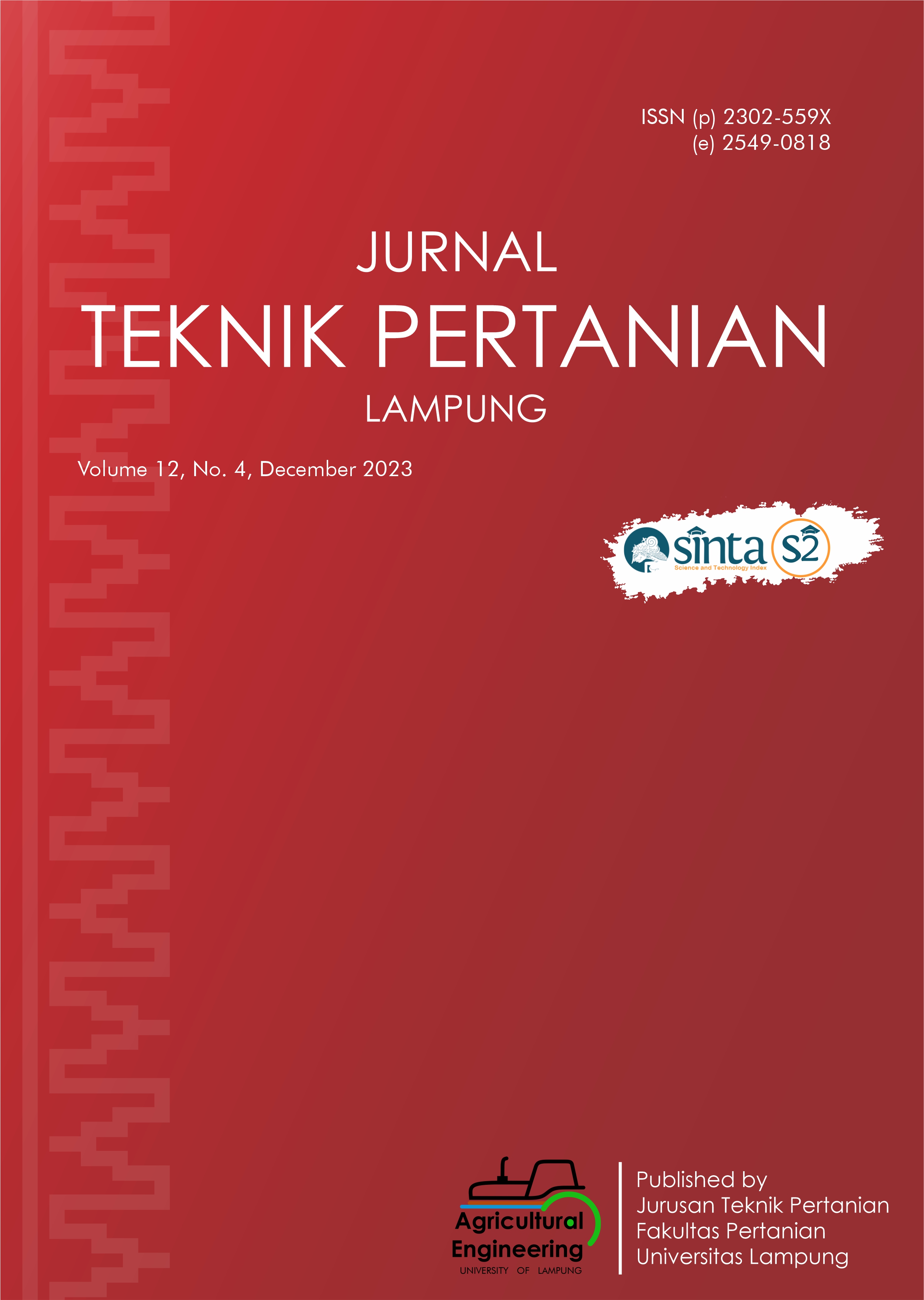Growth and Yield of Tomato (Lycopersicum esculentum Mill.) Due to Application of Hormonic PGR and NPK Fertilizer
DOI:
https://doi.org/10.23960/jtep-l.v12i4.948-956Abstract
Tomatoes have high economic value with community demands increases every year. However, the productivity of tomatoes farmers in Indonesia can not meet the demands of Indonesian consumers. Efforts to solve low productivity in tomatoes cultivation can be made through certains cultivation techniques. The intention of this study is to acquire appropriate combination of Hormonik Plant Growth Regulator (PGR) concentrations and NPK fertilizer dosages for the optimum growth and yield of tomato plants. This study used a factorial experimental method with a completely randomized design (CRD). The first factor is Hormonik PGR concentrations (H) in 4 different treatment levels that consist of control variable (no PGR added) (H0), 6 ml/l (H1), 7 ml/l (H2), and 8 ml/l (H3). The second factor is NPK fertilizer dosages (N) in 4 different treatment levels that consist of 24 g/plant (N1), 32 g/plant (N2), 40 g/plant (N3), and 48 g/plant (N4). This study showed that combination of 6 ml/l Hormonik PGR and 40 g/plant of NPK fertilizer provide the highest number of fruits per plant by 49.0 and the weight of fruit per plant by 1,572.3 g.
Keywords : Concentration of Hormonik PGR, Dose of NPK Fertilizer, Production, Tomato.
References
Amiroh, A. (2016). Kajian pertumbuhan dan produksi tomat (Solanum licopersicum Mill) terhadap zat pengatur tumbuh pada macam konsentrasi. Saintis, 8, 1–12.
Arif, Murniati, A. (2016). Uji beberapa zat pengatur tumbuh alami terhadap pertumbuhan bibit karet (Hevea brasiliensis Muell Arg) stum mata tidur. JOM Faperta, 3(1), 1–10.
Ariyanti, M., Maxiselly, Y., & Soleh, M. A. (2020). Pengaruh aplikasi air kelapa sebagai zat pengatur tumbuh alami terhadap pertumbuhan kina (Cinchona ledgeriana Moens) setelah pembentukan batang di daerah marjinal. Agrosintesa Jurnal Ilmu Budidaya Pertanian, 3(1), p. 12. doi: 10.33603/jas.v3i1.3547.
BPS (Badan Pusat Statistik). (2021). Produksi Tanaman Sayuran 2020. Accessed on 1 December 2023 from: https://www.bps.go.id/indicator/55/61/1/produksi-tanaman-sayuran.html.
Febriantini, M. (2013). Pengaruh pupuk daun green-tama dan ZPT atonik terhadap pertumbuhan dan hasil tanaman tomat (Lycopersicum esculentum Mill) varietas berlian. Jurnal Agrifor, XII(2), 96–109.
Harpitaningrum, P., Sungkawa, I., & Wahyuni, S. (2014). Pengaruh Konsentrasi Paclobutrazol Terhadap Pertumbuhan dan Hasil Tanaman Mentimun (Cucumis sativus L.) Kultivar Venus. Jurnal Agrijati, 25(1), 1–17.
Hasibuan, P.A.N., Rosmawaty, T., & Sulhaswardi, S. (2019). Pengaruh pupuk NPK 16:16:16 dan zat pengatur tumbuh harmonik terhadap pertumbuhan serta produksi tanaman seledri (Apium graveolens L.). Prosiding Webinar Nasional Series: Sistem Pertanian Terpadu dalam Pemberdayaan Petani di Era New Normal (ISSN 9786239504915), 250–264.
Irvandi, D., & Nurbaiti, N. (2017). Pengaruh pupuk NPK dan air kelapa sebagai zat pengatur tumbuh alamiterhadap pertumbuhan bibit kakao (Theobroma Ccacao L.) di medium sub soil. JOM Faperta, 4(2), 1–12.
Khafie, B., Sulistiyono, A., & Pikir, J.S. (2021). Respon hasil tanaman cabai rawit akibat kombinasi konsentrasi paclobutrazol dan dosis pupuk NPK. Agrohita, 6(2), 191–200.
Kurniawati, A.S., Sukendah, & Makhziah, M. (2023). Pengaruh media tanam hayati pada pengembangan padi lokal dengan sistem tanam polybag. Jurnal Pertanian Agros, 25(1), 549–557.
Kurniawati, H.Y., Karyanto, A., & Rugayah, R. (2015). Pengaruh pemberian pupuk organik cair dan dosis pupuk NPK (15:15:15) terhadap pertumbuhan dan produksi tanaman mentimun (Cucumis sativus L.). Jurnal Agrotek Tropika, 3(1), 30–35. http://dx.doi.org/10.23960/jat.v3i1.1894.
Kusumayati, N., Elih, E., & Setyobudi, L. (2015). Tingkat keberhasilan pembentukan buah tiga varietas tanaman tomat (Lycopersicon esculentum Mill.) pada lingkungan yang berbeda. Jurnal Pro, 3(8), 683–688.
Muslimah, Y., Putra, I., & Diana, L. (2016). Pengaruh jenis dan konsentrasi zat pengatur tumbuh organik terhadap pertumbuhan stek lada (Piper nigrum L.). Jurnal Agrotek Lestari, 2(2), 27–36.
Mutryarny, E., & Lidar, S. (2018). Respon tanaman pakcoy (Brassica rapa L) akibat pemberian zat pengatur tumbuh hormonik. Jurnal Ilmiah Pertanian, 14(2), 29–34. https://doi.org/10.31849/jip.v14i2.258
Prasetyo, R. (2014). Pemanfaatan berbagai sumber pupuk kandang sebagai sumber N dalam budidaya cabai merah (Capsicum annum L.) di tanah berpasir. Planta Tropika: Journal of Agro Science, 2(2), 125–132. https://doi.org/10.18196/pt.2014.032.125-132
Rajiman, R. (2018). Pengaruh zat pengatur tumbuh (ZPT) alami terhadap hasil dan kualitas bawang merah. Prosiding Seminar Nasional Dalam Rangka Dies Natalis UNNS Ke-42 Tahun 2018: “Peran Keanekaragaman Hayati Untuk Mendukung Indonesia Sebagai Lumbung Pangan Dunia,†2(1), A327–A335.
Saberan, N., Rahmi, A., & Syahfari, H. (2014). Pengaruh pupuk NPK Pelangi dan pupuk daun Grow Team M terhadap pertumbuhan dan hasil tanaman (Lycopersicum esculentum L.Mill) varietas permata. Jurnal Agrifor, XIII(1), 67–74.
Sugiharto, N.O., Sulistyono, A., & Kusumaningrum, N.A. (2022). Pengaruh konsentrasi pacobutrazol dan dosis pupuk NPK terhadap pertumbuhan dan hasil tanaman tomat (Lycopersicon esculentum). Jurnal Ilmiah Mahasiswa (JIM) Pertanian, 10(1), 55–69.
Triani, N., Permatasari, V.P., & Guniarti, G. (2020). Pengaruh konsentrasi dan frekuensi pemberian zat pengatur tumbuh giberelin terhadap pertumbuhan dan hasil tanaman terung (Solanum melongena L.). Agro Bali: Agricultural Journal, 3(2), 144–155. https://doi.org/10.37637/ab.v3i2.575.
Rahayu, N.Y., Djawartiningsih, R., & Sulistyono, A. (2022). Pengaruh jenis dan tingkat konsentrasi pupuk organik cair terhadap pertumbuhan dan hasil tanaman cabai rawit (Capsicum frutescens). Jurnal Agrium, 19(3), 197-206. https://doi.org/10.29103/agrium.v19i3.8717.
Downloads
Published
Issue
Section
License
- Authors who publish with this journal agree to the following terms:
- Authors retain copyright and grant the journal right of first publication with the work simultaneously licensed under a Creative Commons Attribution-ShareAlike 4.0 International Lice that allows others to share the work with an acknowledgement of the work's authorship and initial publication in this journal.
- Authors are able to enter into separate, additional contractual arrangements for the non-exclusive distribution of the journal's published version of the work (e.g., post it to an institutional repository or publish it in a book), with an acknowledgement of its initial publication in this journal.
- Authors are permitted and encouraged to post their work online (e.g., in institutional repositories or on their website) prior to and during the submission process, as it can lead to productive exchanges, as well as earlier and greater citation of published work (See The Effect of Open Access).
Jurnal Teknik Pertanian Lampung

JTEPL is licensed under a Creative Commons Attribution-ShareAlike 4.0 International License.

